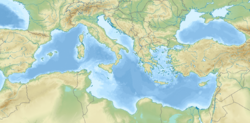Earth:Werfen Formation
From HandWiki
Short description: Geologic formation in Austria, Bosnia and Herzegovina, and Italy
| Werfen Formation Stratigraphic range: Changhsingian-Ladinian ~254–235 Ma | |
|---|---|
| Type | Formation |
| Unit of | Costabella Group |
| Sub-units | Campil, Cencenighe, Gastropod Oolite, Tesero Oolite, Mazzin, Siusi, Val Badia Members |
| Lithology | |
| Primary | Mudstone, lime mudstone, limestone |
| Other | Siltstone, sandstone, marl |
| Location | |
| Coordinates | [ ⚑ ] : 46°48′N 12°06′E / 46.8°N 12.1°E |
| Paleocoordinates | [ ⚑ ] 7°24′N 22°54′E / 7.4°N 22.9°E |
| Region | Upper Austria, Bolzano, South Tyrol, Trentino, Veneto |
| Country | |
| Extent | Dinaric, Southern Limestone & Salzburg Slate Alps, Tennen Mountains |
| Type section | |
| Named for | Werfen |
The Werfen Formation is a geologic formation in the Southern Limestone Alps and Dinaric Alps of Austria, Bosnia and Herzegovina, and Italy. It preserves fossils dating back to the Triassic period.[1]
Fossil content
The formation has provided numerous fossils typical of a shallow lagoon environment, including:
- Eotiaris teseroensis (a crown-group echinoid from Changhsingian aged beds of the Tesero Member)[2]
- Orbicoelia sp. (a brachiopod)[2]
- Teserina nerii (a brachiopod)[2]
Griesbachian aged layers of the formation also preserve an unexpectedly diverse ichnotaxon assemblage, including the ichnogenera Catenichnus, Helminthopsis, Lockeia, Palaeophycus, Planolites, Rhizocorallium, Spongeliomorpha, Taenidium and Thalassinoides.[3]
See also
- List of fossiliferous stratigraphic units in Austria
- List of fossiliferous stratigraphic units in Bosnia and Herzegovina
- List of fossiliferous stratigraphic units in Italy
References
- ↑ Werfen Formation at Fossilworks.org
- ↑ 2.0 2.1 2.2 Thompson, Jeffrey R.; Posenato, Renato; Bottjer, David J.; Petsios, Elizabeth (2019). "Echinoids from the Tesero Member (Werfen Formation) of the Dolomites (Italy): implications for extinction and survival of echinoids in the aftermath of the end-Permian mass extinction". PeerJ 7: e7361. doi:10.7717/peerj.7361. PMID 31531267.
- ↑ Hofmann, Richard; Goudemand, Nicolas; Wasmer, Martin; Bucher, Hugo; Hautmann, Michael (2011). "New trace fossil evidence for an early recovery signal in the aftermath of the end-Permian mass extinction". Palaeogeography, Palaeoclimatology, Palaeoecology 310 (3–4): 216–226. doi:10.1016/j.palaeo.2011.07.014. Bibcode: 2011PPP...310..216H.
Bibliography
- Thompson, Jeffrey R.; Renato Posenato; David J. Bottjer, and Elizabeth Petsios. 2019. Echinoids from the Tesero Member (Werfen Formation) of the Dolomites (Italy): implications for extinction and survival of echinoids in the aftermath of the end-Permian mass extinction. PeerJ 7. e7361. doi:10.7717/peerj.7361 PMID 31531267 PMC 6718154
- Foster, William J.; Silvia Danise; Gregory D. Price, and Richard J. Twitchett. 2017. Subsequent biotic crises delayed marine recovery following the late Permian mass extinction event in northern Italy. PLOS ONE 12. e0172321. doi:10.1371/journal.pone.0172321 PMID 28296886 PMC 5351997 Bibcode: 2017PLoSO..1272321F
Further reading
- E. Farabegoli, M. C. Perri, and R. Posenato. 2007. Environmental and biotic changes across the Permian-Triassic boundary in western Tethys: The Bulla parastratotype, Italy. Global and Planetary Change 55:109-135
- E. Kustatscher, M. Wachtler, and J.H.A. Konijnenburg-van Cittert. 2004. A number of additional and revised taxa from the Ladinian flora of the Dolomites, Northern Italy. Geo.Alp 1:57-69
- R. Posenato. 2009. Survival patterns of macrobenthic marine assemblages during the end-Permian mass extinction in the western Tethys (Dolomites, Italy). Palaeogeography, Palaeoclimatology, Palaeoecology 280:150-167
- A. Bittner. 1890. Brachiopoden der alpinen Trias. Abhandlungen der Kaiserlich-Königlichen Geologischen Reichsanstalt 14:1-325
 |


